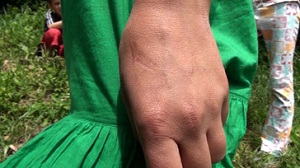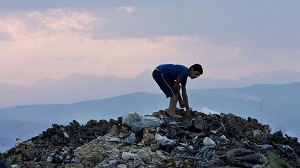International Labor Organization (ILO) 4 route des Morillons, CH-1211 Geneva 22, Switzerland
The following story was written by the ILO Newsroom
___________________________________________________________________________________________________________________________
Poverty pushes a high number of children in Kosovo* to drop out of school and enter child labour as early as 10 years old. The ILO supports efforts of Kosovo’s public institutions and social partners to eliminate child labour, with an emphasis on its worst forms.
Feature | 09 February 2015
PRISTINA (ILO News) – Sevdije Morina, a mother of five, lives in the Kosovar village of Vrajak. The children help her with the hard farm work – harvesting onions and grapes.
“I was forced to stop sending them to school so that they could work more in the fields and the vineyard,” Morina explains.
 |
The children often handle pesticides and dangerous tools. “There have been cases when we’ve been injured when hoeing. And once I cut my hand with an axe,” recalls her 12 year-old daughter Haxhere. “Since we did not have a car or other transportation, we had to walk the six kilometres from Vrajak to Ratkoc to take the children to hospital,” Sevdije Morina adds.
Morina and her four siblings are not the only children in Kosovo who do hazardous work instead of going to school and enjoying a normal childhood.
Risking their health and lives
Coming from poor families, some of them have to start to work as early as the age of 10. Working on a garbage dump or in agriculture, they risk their health and even their lives. For many of them, combining school and work is a major challenge.
Behxhet Gaxhiqi, Advisor on Social Issues to the Minister of Labour and Social Welfare, recognizes the problem: “Because of how it is carried out, child labour harms or abuses the child and deprives him or her of the right to education.”
|
“Child labour harms or abuses the child and deprives him or her of the right to education.” |
| Behxhet Gaxhiqi, Advisor on Social Issues to the Minister of Labour and Social Welfare |
For dozens of children collecting waste at a local dumpsite
in Koshtova, a small village pn the outskirts of the town of
Mitrovica, working conditions may be even more difficult than
for Morina and her children.
They often hurt themselves when they collect the garbage
or run to meet a new truck arriving at the dumpsite. They
rush because the winner of the race takes all and can fill his
or her bag alone. Everybody accepts this tacit agreement to avoid fights between the children.
Labouring at a dumpsite
Labour activist Labinot Berisha has been personally involved in the activities of the Ministry of Culture, Youth and Sports, which in cooperation with NGOs, tries to help these children. “What touched me most was that working at the dumpsite had become a daily routine for these children,” he says.
 |
Other children work in the streets, either begging or selling goods. “Police come across cases of children working in the streets, particularly if it is work linked to illegal activities,” says Avni Zahiti, a police officer in Mitrovica.
But the police officers are not the only cause of stress for these street children. They also face psychological pressure from their families to bring home a certain amount of money.
“One of the main problems children face is stress. Accumulated throughout the years, this leads to insomnia, learning problems and even more serious disorders, including depression,” explains Natyra Agani, a psychologist in Pristina.
Working children cannot wait for better times
Despite these problems, the ILO and the Ministry of Labour and Social Welfare try to find quick and adequate solutions.
“The fact that child labour is closely related to poverty and high unemployment in a country should not give us the comfort of focusing our efforts on long-term action to eradicate poverty and reducing unemployment – assuming that child labour will be eliminated in the long run too,” says Lindita Boshtrakaj, the ILO’s National Programme Manager for the child labour project in Kosovo.
| “Child labour is an unacceptable way of providing financial support to a family,” |
| Lindita Boshtrakaj, the ILO’s National Programme Manager |
“There are many children in hazardous work and they cannot wait that long. This is why immediate action is needed to protect these children.”
“Child labour is an unacceptable way of providing financial support to a family,” she adds. “Public authorities, communities and families all have their share of responsibility in fighting these abuses and they should act on these responsibilities.”
So far, the project has led to the formulation of the Kosovo Action Plan (KAP) for Prevention and Elimination of the Worst Forms of Child Labour (WFCL). The idea is to strengthen the response of public authorities, and workers’ and employers’ organizations to address child labour and raise awareness in communities and families.
The Administrative Instruction 05/2013 on the Prevention and Prohibition of Hazardous Child Labour in Kosovo was approved in July 2014. It contains the updated Hazardous Child Labour List drafted with the help of the ILO.
Since March 2013, members of the Kosovo Chamber of Commerce (KCC) are obliged to observe the ILO’s four fundamental labour principles, including the right to freedom of association and collective bargaining, and the elimination of child labour, forced labour and discrimination at work.
Preventing child labour
The Chamber of Commerce, with ILO support, prepared reports on the situation of child labour in companies and in their supply chains in agriculture, construction, extractive industries and collection of scrap metal. The reports were used to mobilize members of the KCC to take effective measures to prevent child labour.
| “When it comes to the welfare of the child, we can never say that we have done enough.” |
| Behxhet Gaxhiqi |
As a result, forty members of KCC adopted codes of conduct on combating child labour in their supply chains and communities, while the KCC itself has approved its Strategy for Prevention and Elimination of Child Labour 2014-2020.
In addition, occupational safety and health issues will be mainstreamed into the compulsory education (grades 8-9) and upper secondary school curricula. A curriculum on occupational and safety issues was prepared with ILO support and approved by the Ministry of Education Science and Technology.
It will start to be taught in the new school year 2015-2016. Advice to farmers about hazardous child labour in agriculture was also included in the training modules of agriculture advisory services provided by the Ministry of Agriculture Forestry and Rural Development.
Meanwhile, all actors in Kosovo agree that there is still much to be done in the fight against child labour.
“When it comes to the welfare of the child, we can never say that we have done enough,” concludes Behxhet Gaxhiqi, from the ministry of Labour and Social Welfare. “Further work and additional resources will be needed to scale up interventions to withdraw children from the worst forms of child labour.”
* As defined by UN Security Council Resolution 1244, hereafter named as “Kosovo”.